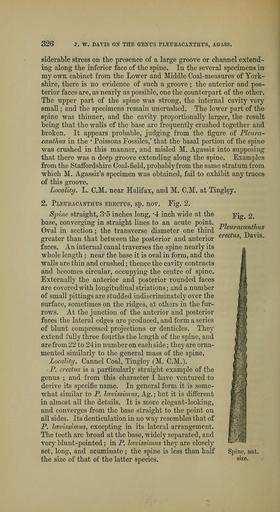MAKE A MEME
View Large Image

| View Original: | The_Quarterly_journal_of_the_Geological_Society_of_London_(12960123555).jpg (1750x3200) | |||
| Download: | Original | Medium | Small | Thumb |
| Courtesy of: | commons.wikimedia.org | More Like This | ||
| Keywords: The Quarterly journal of the Geological Society of London (12960123555).jpg 326 J w DAYis oiq- the genus pletjeacanthtjs agass <br> siderable stress on the presence of a large groove or channel extend- <br> ing along the inferior face of the spine In the several specimens in <br> my own cabinet from the Lower and Middle Coal-measures of York- <br> shire there is no evidence of such a groove ; the anterior and pos- <br> terior faces are as nearly as possible one the counterpart of the other <br> The upper part of the spine was strong the internal cavity very <br> small ; and the specimens remain un crushed The lower part of the <br> spine was thinner and the cavity proportionally larger the result <br> being that the walls of the base are frequently crushed together and <br> broken It appears probable judging from the figure of Plevra- <br> cantJms in the ' Poissons Fossiles ' that the basal portion of the spine <br> was crushed in this manner and misled M Agassiz into supposing <br> that there was a deep groove extending along the spine Examples <br> from the Staffordshire Coal-field probably from the same stratum from <br> which M Agassiz's specimen was obtained fail to exhibit any traces- <br> of this groove <br> Locality L CM near Halifax and M CM at Tingley <br> 2 Pleueacanthtts eeectus sp nov Fig 2 <br> Sjoine straight 3'5 inches long 4 inch wide at the p j~ 2 <br> base converging in straight lines to an acute point <br> Oval in section ; the transverse diameter one third - ' «c« / f S <br> greater than that between the posterior and anterior ' ® <br> faces An internal canal traverses the spine nearly its <br> whole length ; near the base it is oval in form and the <br> walls are thin and crushed ; thence the cavity contracts <br> and becomes circular occupying the centre of spine <br> Externally the anterior and posterior rounded faces <br> are covered with longitudinal striations ; and a number <br> of small pittings are studded indiscriminately over the <br> surface sometimes on the ridges at others in the fur- <br> rows At the junction of the anterior and posterior <br> faces the lateral edges are produced and form a series <br> of blunt compressed projections or denticles They <br> extend fully three fourths the length of the spine and <br> are from 22 to 24 in number on each side ; they are orna- <br> mented similarly to the general mass of the spine <br> Locality Cannel Coal Tingley M CM <br> - P erectus is a particularly straight example of the <br> genus ; and from this character I have ventured to <br> derive its specific name In general form it is some- <br> what similar to P Icevissimus Ag ; but it is different <br> in almost all the details It is more elegant-looking <br> and converges from the base straight to the point on ; <br> all sides Its denticulation in no way resembles that of <br> P Icevissimus excepting in its lateral arrangement <br> The teeth are broad at the base widely separated and \ <br> very blunt-pointed ; in P Icevissimus ihej aie closely ' ' ' – <br> set long and acuminate ; the spine is less than half Spine nat <br> the size of that of the latter species size 36090685 111264 51125 Page 326 Text 36 http //www biodiversitylibrary org/page/36090685 1880 Geological Society of London NameFound Icevissimus ihej NameFound P erectus NameFound Pleueacanthtts eeectus sp Biodiversity Heritage Library The Quarterly journal of the Geological Society of London v 36 1880 Geology Periodicals Smithsonian Libraries bhl page 36090685 dc identifier http //biodiversitylibrary org/page/36090685 smithsonian libraries Information field Flickr posted date ISOdate 2014-03-06 Check categories 2015 August 26 CC-BY-2 0 BioDivLibrary https //flickr com/photos/61021753 N02/12960123555 2015-08-26 15 51 32 cc-by-2 0 PD-old-70-1923 The Quarterly journal of the Geological Society of London 1880 Photos uploaded from Flickr by Fæ using a script | ||||